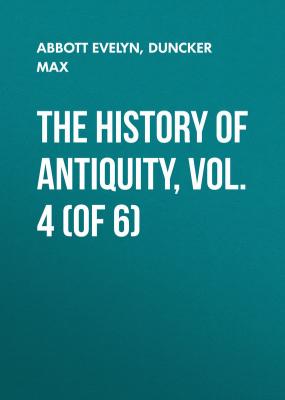ТОП просматриваемых книг сайта:
The History of Antiquity, Vol. 4 (of 6). Duncker Max
Читать онлайн.Название The History of Antiquity, Vol. 4 (of 6)
Год выпуска 0
isbn
Автор произведения Duncker Max
Издательство Public Domain
136
"Vishnu-Purana," ed. Wilson, p. 380,
137
Lassen, "Ind. Alterth." 12, Anhang xviii. n. 4.
138
In the Rigveda we find: "If you, Indra and Agni, are among the Druhyus, Anus or Purus, come forth."
139
Lassen,
140
"Rigveda," 1, 31, 4; 1, 31, 17; 7, 18, 13.
141
According to the Brahmanic recension of the poem which we now possess, Samvarana is able to obtain the daughter of the god only by the mediation of a sacred priest. The king therefore bethinks him of Vasishtha, who ascends to the god of light and obtains his daughter for the king. Lassen, "Ind. Alterth." 12, Anhang xxvi.
142
Lassen, "Ind. Alterth." 12 656, n. and 12 850.
143
A. Weber, "Ind. Literaturgesch." s. 1262.
144
Manu, 7, 90, 93. Yajnavalkya, 1, 323-325.
145
Panini in M. Müller, "Hist. of anc. Sanskrit Literature," p. 44,
146
Manu, 9, 59.
147
M. Müller,
148
"Vishnu-Purana," ed. Wilson, p. 440. Lassen, "Ind. Alterth." 12, 68 ff.
149
In Panini Krishna is called a god, but also a hero. M. Müller, "Hist. of anc. Sanskrit Lit." p. 45
150
On the form of the Rama legend in the Daçaratha-Jataka, cf. A. Weber, "Abh. Berl Akad." 1870. The Vishnu-Purana enumerates 33 kings of the Koçalas from Daçaratha to Brihadbala, who falls in the great battle on the side of the Kurus. Including these this Purana makes 60 kings between Manu and Daçaratha. For the same interval the Ramayana has only 34 names, of which some, like Yagati, Nahusha, Bharata, are taken from the genealogical table of the kings of the Bharata, others, like Pritha and Triçanku, belong to the Veda. We have already seen that the series of the Bharata kings give about ten generations between the time when they gained the upper hand on the Yamuna and upper Ganges,
151
Cunningham, "Survey," 1. 301 ff.
152
Lassen,
153
Lassen, "Ind. Alterth." 12, 168.
154
Lassen,
155
Manu, 1. 91.
156
Lassen,
157
"Samaveda," 1, 6, 1, 4, 5, in Benfey's translation.
158
Muir, "Sanskrit Texts," 5, 266 ff.
159
"Rigveda," 1, 40, 5, in Muir,
160
"Rigveda," 10, 68, 8 ff. Roth, "Z. D. M. G." 1. 75.
161
162
Roth,
163
Muir,
164
So in Manu,
165
"Rigveda," 10, 72, 1-3; 10, 129, 1-6, in Muir,
166
Manu, 1, 28, 29.
167
"Rigveda," 10, 90; Manu, 1, 31 and in the Puranas; Muir, "Sanskrit Texts," 5, 371. A. Weber, "Ind. Studien," 9, 7.
168
Manu, 1, 88-91, and in many other places.
169
In Manu, 4, 88-90 (cf. 12, 75, 76) eight hells are mentioned and described, in each of which the torments grow worse as the offences are more serious. The Buddhists retain these eight hot hells, and add eight cold; Burnouf, "Introduction à l'histoire du Bouddhisme," p. 320, 366, 367, 201. The Singhalese have increased the number to 136, the Siamese to 462. Koppen, "Relig. des Buddha," s. 244. Cf. A. Weber, in "Z. D. M. G." 9, 237.
170
171
Manu, 12, 43, 44.
172
Manu, 12, 59.
173
Manu, 12, 55.
174
Manu, 12, 62, 64.
175
Manu, 12, 67.
176
Manu, 12, 58.
177
Manu, 12, 59. Burnouf, "Introduction," p. 274. Bohlen has already observed that many of these regenerations are merely fanciful, "Indien," 24.
178
Manu, 6, 61-63.
179
In the sixth century B.C. the Brahmanic arrangement of the state was in full force in the cities on the Ganges, and carried out most strictly. Hence it must have obtained the upper hand about 800 B.C. at the latest. It was not only established by law about the year 600 B.C., but the doctrine of the Brahmans had already created scholastic and heterodox systems of philosophy. Before this system could become current, the idea of Brahman must have been discovered; the strong elements of resistance in the ancient life and faith must have been overcome. This would occupy a space of about two centuries, and may therefore have

